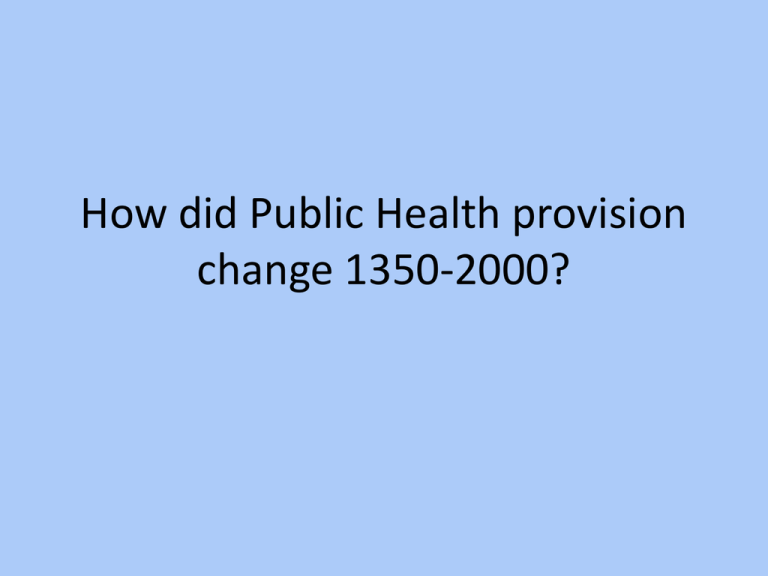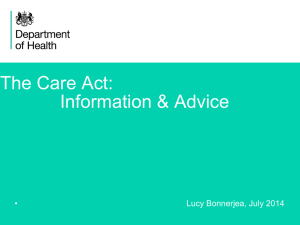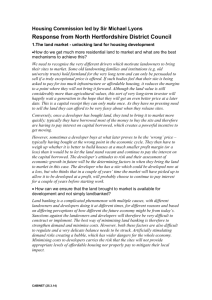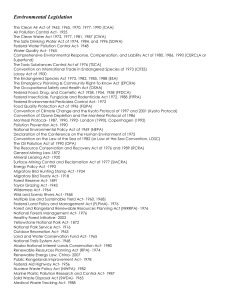The development of water supplies and sanitation
advertisement

How did Public Health provision change 1350-2000? Roman Public Health: • Water Supply- fresh water was supplied from springs by aqueducts and brick conduits and stored in reservoirs. • Public Baths- every town had baths, which were cheap to use. These helped people get rid of fleas. • Toilets- public toilets could seat up to 20 around three sides of the room, private cubicles were rare. Some rich people also had private toilets at home. • Drains and sewers- they emptied dirty water and waste into nearby rivers. • Towns and forts were built at the bottom of hills where air was believed to be cleaner. Public Health after the Romans Why did the Romans have such good PH?- for healthy soldiers in their army, because slaves did the hard work, because they collected enough taxes from the Empire to pay for it and because they believed in order and discipline. • The Saxons and Vikings had no interest in PH because they were busy trading, farming and fighting. • Roman PH fell into disuse, fields and woods were used as toilets, human and animal waste was thrown into rivers which were also used for drinking water. Case Study 1: The Black Death, 1348 • It arrived in England in 1348 from Asia. Approx 40% of the population died. Outbreaks followed in 1361, 1369, 1374 and 1390. • Two forms- bubonic spread by fleas and pneumonic spread by germs in saliva. • People were terrified and tried to run away- even the King left London after telling the Church to lead prayers. • Basically, there was no real lead by the government. • See sheet on 14th Century London. Case Study 2: The Great Plague, 1665. • In 1665 London was hit by the worst plague it had seen in 300 years. • This time a range of orders were published by the Mayor of London to try and limit the spread of the plague. The King left the city, again, and took his council with him. • Orders= shutting up sick in their houses with a guard and a red cross on the door, people had to sweep outside their house and remove filth, no animals kept in the city or beggars allowed on the street, no plays or public entertainment, women searchers and doctors to confirm the death from plague, burials after sunset with no mourners allowed, all bedding from homes of the dead to be aired with fire and then perfumed. The development of water supplies and sanitation. • • Water Supply: In the 13th Century lead pipes were laid to bring water from the river Tyburn to London and people would go to the pool at the end to collect water. There were also water sellers in the streets but their water was usually taken from a polluted river. 1602 Edmund Colthurst suggested building a 38 mile artificial river to bring water to London from Hertfordshire. The project relied on gravity, which made planning it difficult and Colthurst ran out of money afetr only two miles. His idea was picked up by Sir Hugh Myddleton in 1609 who offered to pay for the work. Landowners on the route protested but he had King James’ support and they paid half each. The project was finished in 1613. The supply od water could not keep up though with demand and most people still used wells or water sellers. By 1750, most water was supplied by private water companies. Sanittation: In Medieval times, toilets were usually a wooed seat over a cess pit and people used leaves or moss to wipe themselves. Some people put ashes over the sewage to reduce the smell, and then they were regularly emptied- these were called earth closets. Most people used chamber pots at home and threw the contens out the window. In 1596 Sir John Harrington invented a water closet which used water to wash away sewage but most people ridiculed it and they were really used for another 200 years. The main problems with living conditions in towns in the early 1800s. • Overcrowding- people migrated from towns and populations rose rapidly, there was a building frenzy to make profit. Whole families often lived in one room and infection spread easily. • Damp- there were no building regulations so they were poorly built. Foundations were shallow and floors were laid on bare earth. Roofs leaked. Damp often leads to chest infections like TB. • Poor ventilation- Houses were built close together and back to back which meant few windows. • Food- there were few cooking facilities and food couldn’t be stored for long. Families had to buy food in small quantities and their diet was basic. • Water Supply- most people collected water from standpipes supplied by water companies. Some people collected it from rivers even though they were polluted and people rarely washed themselves or their clothes. • Refuse and sewage- there was no system for collecting rubbish, houses were built without toilets or sewers. Groups of houses shared privies which often overflowed. Cholera! • Cholera is spread by infected water and occasionally there were outbreaks until people moved to towns and cities after industrialisation. There were bad outbreaks in 1832, 1848 and 1854. It caused death for many within hours- diarrohea, dehydration and organs fail. • John Snow- he proved that Cholera is caused by drinking infected water after studying the 1854 outbreak. • He was a London doctor who observed, researched and studied the outbreak, conducting interviews and visiting the area around Broad Street. • He believed one pump was to blame for the disease so he had the handle removed and deaths stopped almost immediately. • How did he know? Most people who died lived within a few miles of Broad Street. Nobody became ill at a Brewery next to the pump because it had it’s own well. A widow living in the suburbs had water collected from the pump taken to her home, she became ill and died. In mot cases the people who died took water from the pump. Edwin Chadwick and Public Health Reform. • Edwin Chadwick- Civil Servant in the 1830s employed by the Poor Law Commission who supervised use of rates to help the poor. He was asked to investigate poor living conditions and causes of ill health. • He wrote in his 1842 report that poor living conditions cause ill health and it would be cheaper for tax payers to improve living conditions and have fewer poor, sick people. • He suggested: 1. removing cleaning people and their homes and encouraging better ventilation. 2. Putting in drainage and removing waste, supplying free clean water. 3. Appointing Medical Officers in each area to monitor health. Why was there little Public Health Provision 1750-1830? Ideas and Beliefs Laissez- faire argued that the gov’t should not interfere in people’s lives as this would artificially support the weak. They believed people having responsibility for their own lives (survival of the fittest) was the best way for society to improve. (Social Darwinism). They believed that the gov should allow each local area to control its own affairs. This meant local rate payers made the decisions, these people did not want to pay for improvements to sewers and piped water- they were nicknamed the ‘dirty party’. Money Those who opposed increased gov’t intervention were concerned about the cost of increased gov’t activity in terms of local rates (taxes). Rich people didn’t feel they should pay to deal with PH problems in poor areas. They were looking to reduce costs not increase them. Many of the local councillors actually owned water companies or were landlords of poor properties- so no intention of paying to tidy up living conditions. Govt Gov was chosen by minority of people- only rich landowners could vote. This meant that the gov policies were designed to appeal to the rich people who vote for them, and the rich people were not extremely concerned about living conditions for the poor. The gov knew that any attempt to force local councils to follow the recommendations would be unacceptable. Local businessmen and politicians would not accept being told by the gov to pay for PH reforms. 1848 after the second outbreak of cholera parliament approved the 1848 PH Act, this established a system run the gov Board of Health to encourage not force local authorities to improve their area. Authorities only made improvements if rate payers approved- they could borrow money to pay for the improvements-£11 million was borrowed between 1848 and 1872, but only a few authorities took on the measures. 1872 only 50 councils had appointed medical officers. Why was progress made by 1900? ① New voters- 1867 working class men got the vote. ② Weakening of laissez-faire as the gov realised it was in their interest to help people. ③ Education- from 1870 the gov made local authorities set up schools, health education was taught and people could read pamphlets. ④ Cities led the way- Leeds had a pressure group who backed change and newspapers supported them. A local firm got a court order preventing sewage being pumped into the river. ⑤ Cholera- returned in 1865. ⑥ Statistics- from 1837 records of births, deaths with causes etc were kept and Chadwick used these to prove his points. ⑦ Scientific developments- Germ Theory 1861 proved the link between dirt and disease. The Main developments in PH provision in the 19th Century • • • • • • • • • • • • • 1802 Factory Acts 1840- Govt commission set up to investigate PH problems. 1848- The first PH act- a general board of health was set up to co-ordinate PH monitoring. Had 4 national medical officers. - Local authorities were encouraged to set up local boards of health, but it was only compulsory if the death rate was extremely high (23 in 1000) 1852 Compulsory Smallpox vaccination. 1858- Local authorities could establish a Board of Health without interference from the General Board. Regulation of doctor’s qualifications. 1866- Sanitary Act- All towns had to appoint inspectors to check water supplies and drainage. 1872- Public Health Act – sanitary authorities were set up to inspect the worst cases of overcrowding and the appointment of medical officers of health was made compulsory. 1875- Artisan Dwelling Act- Local authorities were given the power to buy and demolish slum housing. 1875- Public Health Act- it was made compulsory for towns to appoint health inspectors and sanitary inspectors and local authorities given powers to enforce regulations on water supplies and sanitation. 1876 laws against pollution of rivers. Laws for building regulations. Food regulations introduced. 1878- PH Act- consolidated existing laws. 1889- Isolation hospitals built. What factors aided progress in PH in the early 20th Century? • Individuals- Charles Booth (1891-1903) Life and Labour of the People in London and Seebohm Rowntree (1888-1901) Poverty: A Study of Town Life conducted surveys that highlighted how difficult it was for the poor to afford decent housing and food. • War- When Britain was involved in the Boar War 1899-1902 it was found that 1/3 of volunteers for the army had to be turned down for duty as they were deemed not medically fit (figure rose to 90% in slum industrial areas). • Government- The conditions of volunteers for the Boer War shocked volunteers into action. The Liberal Govt elected in 1905 began to pass laws that they hoped would improve health among the poor- included the National Insurance Act 1911- this meant any worker earning over £160 a year would contribute alongside their employer and the govt. This would entitle them to Free Medical Treatment and medicine, sick pay for up to 6 months and support payment while unemployed for up to 15 weeks. What difference did the Liberal Government of 19061914 make? • • • • • • • • • • In 1906, a new Liberal gov’t was elected with a majority landslide. The Liberals raised taxes to make the changes below. 1902 Compulsory training for midwives 1906 Meals provided free for school children in need 1907 All births had to be notified to the local medical officer of health. A health visitor visited mothers to check they could care for the baby. 1907 Nurses or doctors had to check all children in schools. 1907 Schools for mothers opened, which taught the importance of hygiene and the danger of diarrhoea in infants, how flies spread disease, breast feeding was better than bottle and good mothering was to be performed for King and country. 1908 Old age pensions were paid to people over 70 who did not have enough money to live on. 1909 Back to back housing was banned. 1911 National Insurance Act providing help for the sick-workers and employers pay in but only protected them, not their family. 1912 Clinics held in schools to give free medical treatment Healthier Housing and Air • Healthier Housing- Step 1- Back-to-backs banned- these were poorly built, badly ventilated, no water supply, only toilets on the end of the block. 1909 banned by gov. local auth’s had to submit planning schemes. Stage 2- Homes for Heroes a reward for men who had risked their lives. 1919 Housing Act meant authorities had provide good quality homes for all w/c people. Helped create ¼ million new homes. Stage 3- Slum Clearance- 5 yr programme started. 1930s 700,000 new homes built by authorities but many slums stayed till 1970s when replaced by high rise blocks. • Cleaner Air- 1952 smog over London, 4000 died of respiratory disease. 1956 Clean Air Act passed controlling what fuel could be burned in homes. By 1971 smoke pollution reduced by 65%. Why was the NHS introduced? • 1939 when war broke out the gov needed improved medical care for potential casualties. By 1942 they wanted to organise health care better. William Beveridge, a civil servant put forward an idea for ‘a free national health service.’ He said it should be comprehensive in the sense for all people and for all forms of health care. • What does it provide? Problems and achievements of the NHS • Problems- Local authorities and bodies opposed the nationalisation of over 3000 hospitals. Arguments raged over the costs. The BMA opposed because doctors didn’t want to be controlled and paid by the gov. • There have had to be compromises- prescription and dental charges, lack of funding and beds, waiting lists etc. • Achievements- made women’s health a priority and their life expectancy rose from 66 to 78 by 2000. GPs now have the chance to work as part of a team and have become increasingly central to health care. Exam Practice • Qu 1: How important was the work of Edwin Chadwick in improving public health in towns in the 19th century? • Qu 2: Why did the government take action to improve public health in the 19th century?











